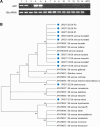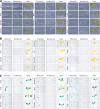Bacillus Strains as Effective Biocontrol Agents Against Phytopathogenic Bacteria and Promoters of Plant Growth
- PMID: 38801423
- PMCID: PMC11129970
- DOI: 10.1007/s00248-024-02384-1
Bacillus Strains as Effective Biocontrol Agents Against Phytopathogenic Bacteria and Promoters of Plant Growth
Abstract
Modern crop production relies on the application of chemical pesticides and fertilizers causing environmental and economic challenges. In response, less environmentally impactful alternatives have emerged such as the use of beneficial microorganisms. These microorganisms, particularly plant growth-promoting bacteria (PGPB), have demonstrated their ability to enhance plant growth, protect against various stresses, and reduce the need for chemical inputs. Among the PGPB, Bacillus species have garnered attention due to their adaptability and commercial potential. Recent reports have highlighted Bacillus strains as biocontrol agents against phytopathogenic bacteria while concurrently promoting plant growth. We also examined Bacillus plant growth-promoting abilities in Arabidopsis thaliana seedlings. In this study, we assessed the potential of various Bacillus strains to control diverse phytopathogenic bacteria and inhibit quorum sensing using Chromobacterium violaceum as a model system. In conclusion, our results suggest that bacteria of the genus Bacillus hold significant potential for biotechnological applications. This includes developments aimed at reducing agrochemical use, promoting sustainable agriculture, and enhancing crop yield and protection.
Keywords: Bacillus; Phytopathogen biocontrol; Plant growth promotion; Quorum sensing inhibition.
© 2024. The Author(s).
Conflict of interest statement
The authors declare no competing interests.
Figures





Similar articles
-
A look into a multifunctional toolbox: endophytic Bacillus species provide broad and underexploited benefits for plants.World J Microbiol Biotechnol. 2018 Jun 13;34(7):94. doi: 10.1007/s11274-018-2479-7. World J Microbiol Biotechnol. 2018. PMID: 29900507 Review.
-
Antagonist effects of strains of Bacillus spp. against Rhizoctonia solani for their protection against several plant diseases: Alternatives to chemical pesticides.C R Biol. 2019 Jun-Aug;342(5-6):124-135. doi: 10.1016/j.crvi.2019.05.002. Epub 2019 Aug 9. C R Biol. 2019. PMID: 31402177 Review.
-
Enhancing crop disease management through integrating biocontrol bacteria and silicon fertilizers: Challenges and opportunities.J Environ Manage. 2024 Dec;371:123102. doi: 10.1016/j.jenvman.2024.123102. Epub 2024 Oct 30. J Environ Manage. 2024. PMID: 39471603 Review.
-
Volatiles produced by Bacillus mojavensis RRC101 act as plant growth modulators and are strongly culture-dependent.Microbiol Res. 2018 Mar;208:76-84. doi: 10.1016/j.micres.2017.12.014. Epub 2018 Jan 3. Microbiol Res. 2018. PMID: 29551214
-
Plant Growth Promotion Function of Bacillus sp. Strains Isolated from Salt-Pan Rhizosphere and Their Biocontrol Potential against Macrophomina phaseolina.Int J Mol Sci. 2021 Mar 24;22(7):3324. doi: 10.3390/ijms22073324. Int J Mol Sci. 2021. PMID: 33805133 Free PMC article.
Cited by
-
The role of Bacillus species in the management of plant-parasitic nematodes.Front Microbiol. 2025 Jan 17;15:1510036. doi: 10.3389/fmicb.2024.1510036. eCollection 2024. Front Microbiol. 2025. PMID: 39895938 Free PMC article. Review.
-
Impact of Simultaneous Nutrient Priming and Biopriming on Soybean Seed Quality and Health.Plants (Basel). 2024 Sep 11;13(18):2557. doi: 10.3390/plants13182557. Plants (Basel). 2024. PMID: 39339532 Free PMC article.
-
In vitro and In silico investigation deciphering novel antifungal activity of endophyte Bacillus velezensis CBMB205 against Fusarium oxysporum.Sci Rep. 2025 Jan 3;15(1):684. doi: 10.1038/s41598-024-77926-1. Sci Rep. 2025. PMID: 39753601 Free PMC article.
-
Enhancing the Growth of Chili Plants and Soil Health: Synergistic Effects of Coconut Shell Biochar and Bacillus sp. Strain Ya-1 on Rhizosphere Microecology and Plant Metabolism.Int J Mol Sci. 2024 Oct 18;25(20):11231. doi: 10.3390/ijms252011231. Int J Mol Sci. 2024. PMID: 39457013 Free PMC article.
-
Differential responses of root and leaf-associated microbiota to continuous monocultures.Environ Microbiome. 2025 Jan 27;20(1):13. doi: 10.1186/s40793-025-00675-9. Environ Microbiome. 2025. PMID: 39871332 Free PMC article.
References
-
- Kleinwechter U, Gastelo M, Ritchie J, Nelson G, Asseng S. Simulating Cultivar variations in Potato yields for contrasting environments. Agric Syst. 2016;145:51–63. doi: 10.1016/j.agsy.2016.02.011. - DOI
-
- Szilagyi-Zecchin VJ, Ikeda AC, Hungria M, Adamoski D, Kava-Cordeiro V, Glienke C, Galli-Terasawa LV. Identification and characterization of Endophytic Bacteria from Corn (Zea Mays L.) roots with biotechnological potential in Agriculture. AMB Express. 2014;4:26. doi: 10.1186/s13568-014-0026-y. - DOI - PMC - PubMed
MeSH terms
Substances
Supplementary concepts
LinkOut - more resources
Full Text Sources

